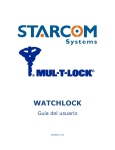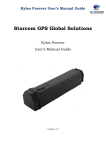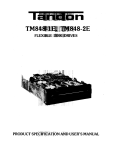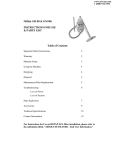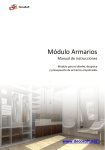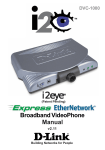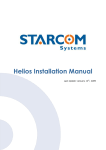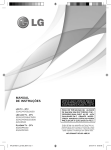Download Triton R - User Guide - English
Transcript
TRITON R User Guide Version 1.0 Triton R User Guide August 2014 COPYRIGHT © STARCOM SYSTEMS, ALL RIGHTS RESERVED. Distribution of substantively modified versions of this document is prohibited without the explicit permission of the copyright holder. Distribution of this work, or of a derivative thereof, in any standard (paper) book form for commercial purposes is prohibited unless prior permission is obtained from the copyright holder. DOCUMENTATION IS PROVIDED «AS IS» AND ALL EXPRESS OR IMPLIED CONDITIONS, REPRESENTATIONS AND WARRANTIES, INCLUDING ANY IMPLIED WARRANTY OF MERCHANTABILITY, FITNESS FOR A PARTICULAR PURPOSE OR NON-INFRINGEMENT, ARE DISCLAIMED, EXCEPT TO THE EXTENT THAT SUCH DISCLAIMERS ARE HELD TO BE LEGALLY INVALID. 2 Triton R User Guide Contents 1 Introduction _________________________________________ 5 2 Package Contents _____________________________________ 6 3 Product Description ____________________________________ 7 Sensors __________________________________________ 8 Buttons and LEDs __________________________________ 9 Technical specifications_____________________________ 11 Industry approvals and certifications __________________ 12 4 Configuration ________________________________________ 13 Downloading the Software __________________________ 13 Installing the Software _____________________________ 13 Installing the Update_______________________________ 17 Installing the cable driver ___________________________ 19 Connecting and disconnecting the unit parts ____________ 20 Inserting the SIM card _____________________________ 21 Connecting the unit to the computer ___________________ 24 Configuring the unit _______________________________ 25 Network settings __________________________________ 31 Transmission Rates settings _________________________ 33 Hardware settings _________________________________ 35 Saving the configuration ____________________________ 37 Configuring a new unit with the saved configuration ______ 37 5 Testing _____________________________________________ 38 TCP test _________________________________________ 38 GPS test _________________________________________ 39 Unit Status_______________________________________ 40 6 Installation _________________________________________ 41 7 Monitoring __________________________________________ 44 Home ___________________________________________ 45 3 Triton R User Guide Resources _______________________________________ 46 Units _______________________________________ 46 Groups _____________________________________ 49 Users ______________________________________ 50 Perimeters __________________________________ 53 Plans ___________________________________________ 56 Monitor _________________________________________ 62 Map ____________________________________________ 65 Reports _________________________________________ 70 Scheduled reports ____________________________ 72 Profile __________________________________________ 75 Help ____________________________________________ 77 Appendix A – Unit Communication in Starcom Systems _________ 78 Appendix B – Contacts __________________________________ 80 4 Triton R User Guide 1 Introduction Triton R is a sophisticated real-time container tracking device designed for monitoring and management purposes. It allows full control of various events and situations by automatic remote tracking, provides system stability and continuity of operations. Utilizing its built in sensors, GPS location tracking and GPRS facilities for message communication the system can detect when the container has reached the customer and inform the recipient of every movement of the container. Any damage, blow or breaking into the container can be reported by email and SMS. The device is easily installed on the container door frame and performs the monitoring of the container state and location. The system provides alerts on various events, such as door opening, breaking in through the side wall, door forcing, container tilt, fall, impact, etc. 5 Triton R User Guide 2 Package Contents 1 4 2 3 1. Triton R unit 2. Triton R USB programming cable 3. Unit key 4. AC charger WARNING: Use only the charger provided by Starcom Systems to charge the Triton R battery. Using any other charger could damage your device or battery. 6 Triton R User Guide 3 Product Description 1. Tail – part of Triton R which registers the container condition information received from the sensors. This part contains a light sensor, humidity and temperature sensor, accelerometer, and a ZigBee module, which can be used to connect external sensors. The Door button is located here. This part contains the magnets for fast attachment to the container door frame. When Triton R is installed in the container, the sensor part of the Tail is located inside the container. 7 Triton R User Guide 2. Main – main part which contains the CPU, GSM and GPS modules and antennas, SIM card slot, and battery. This part contains a Micro-USB socket used for charging and connecting the unit to the computer. The Operation (On/Off) button is located here. When Triton R is installed in the container, this part is located outside the container. 3. Battery – additional unit battery. When Triton R is installed in the container, this part is located outside the container. Sensors Triton R incorporates several sensors to monitor and report various event types. Triton R also allows to connect external sensors of the same version as its internal sensors. Light sensor – detects a change of light inside the container (e.g. breaking into the container). Acceleration sensor – detects impacts to the container. Humidity and temperature sensor – detects temperature and humidity around the unit (can be configured for high and low temperature alerts from -127°C to +127°C and high and low humidity alerts). 8 Triton R User Guide Buttons and LEDs 1. Door button – button which responds when the container door is open/closed. 2. Operation button – button which serves for testing the Triton R operation. When the Main part is disconnected from the Tail, this button serves as On/Off button. 3. LED indicators – the LED indicators located on the Main part and the Battery part will light up when the unit is charging or operating. To turn the Main on, press and hold the Operation button. The LED will flash 5 times with a white light and then turn green (if the battery is fully charged), or red (if the battery is used). When continuing to press the Operation button over 3 seconds, the LED will turn white and start sending a "Button On" message. 9 Triton R User Guide After this the LED will blink green until the unit successfully sends a message (or 5 minutes have passed). The LED will blink red until the unit successfully finds the GPS position (or 5 minutes have passed). To turn the Main off, use the key and disconnect it from the Tail. Then press and hold the Operation button until the light turns white and then turns off. When the Door button is pressed on the Tail (Door closed), the LED on the Main will emit 2 blue blinks. When the Door button is unpressed (Door open), the LED will emit 3 blue blinks. While the unit is charging the red LED will light up, when fully charged the green LED will light up. To check the battery status on the Main part, or on the Battery part, press the Operation button and hold it for a second. If the LED turns green, the battery is fully charged. If the LED turns red, the battery is used and needs charging. 10 Triton R User Guide Technical specifications Supply Voltage Operating 3.7 V Up to 90% Humidity Measurements 40 x 25 x 4 cm (15.7 x 9.8 x 1.6 inch), 621 gr (21.9 oz) Cellular GSM/GPRS (default) Quad Band (850, 900, 1800, 1900) Communication Optional Modems UMTS/HSPA+, CDMA/1xRTT/EV-DO, LTE Antenna type Built-in (concealed) Data channels SMS & TCP/IP Protocol Propriety – encrypted Type GPS, GLONASS (optional) Time to First Fix 2 sec (hot start) Location (TTFF) Positioning Accuracy 10m CEP (50%) Velocity: 0.2m/s (50%) CPU Capacity Antenna Type Built in (concealed) Static RAM 128 Kb Nonvolatile Memory 34 Kb Flash Memory 2048 Kb Range -45°C to +125°C Accuracy ± 0.2°C Range 0% RH to 100% RH Accuracy ± 1.8 % RH Scale ± 8g Accuracy ± 2.5% Resolution 0.025 LUX Sensitivity 0 - 104,448 LUX (Sunlight) Sensors Temperature Humidity Accelerometer Light 11 Triton R User Guide Inputs Push-button 1 Door Switch 1 Type Li-Ion Capacity 5200 mAh Power Sleep/Idle 0.05 mAh Consumption GPS only 75 mAh GPRS only 100 mAh GPS and GPRS 165 mAh Type TTL Battery Pack Access Port Industry approvals and certifications For available certificates, see: http://wiki.starcomsystems.com/wiki/index.php/Marketing#Certifications. 12 Triton R User Guide 4 Configuration Downloading the Software Please download the INSTALLER application. Please contact the technical support department for details. Installing the Software Locate the folder where you saved the installer setup file. Double-click the InstallSetup.exe. The Open File dialog box appears. Click Run. A Windows Security dialog box appears. Click Yes. The Welcome to the Starcom Installer Application Setup Wizard window appears. 13 Triton R User Guide Click Next. The Select Destination Location window appears. 14 Triton R User Guide Click Next. The Select Components window appears. Click Next. The Select Start Menu Folder window appears. 15 Triton R User Guide NOTE: Select Don’t create a Start Menu folder checkbox, if you do not want to create a start menu folder. Click Next. The Ready to Install window appears. Click Install. The installation starts and a progress bar appears in the window, indicating the progress of the installation. 16 Triton R User Guide When the installation is complete, the Completing the Starcom Installer Application Setup Wizard window appears. Click Finish. Installing the Update To install the Installer update software, locate the folder where you saved the update file. Double-click IUpdate.exe. The Open File dialog box appears. 17 Triton R User Guide Click Run. The Starcom Installer Update window appears. Verify that the Destination folder points to the location where the Starcom Installer software is installed and click Install. A Windows Security dialog box appears. Click Yes. The Confirm file replace dialog box appears. Click Yes to All. The installation starts and a progress bar appears in the window, indicating the progress of the installation. 18 Triton R User Guide The Starcom Installer Update window closes, when the update is complete. Installing the cable driver The Triton R cable driver can be downloaded from the following link: http://www.ftdichip.com/Drivers/VCP.htm Download the driver for the proper Windows version. The driver Installation Guide can be found at the following location: http://www.ftdichip.com/Support/Documents/InstallGuides.htm Download the Installation Guide for the proper Windows version. Follow the instructions in the Guide to install the cable driver. 19 Triton R User Guide Connecting and disconnecting the unit parts To connect the Main part and the Battery to the Tail, insert the part into the port on the side of the Tail, turn and push it inwards until it clicks into place. To disconnect the Main part and the Battery, use the plastic key. Push the key into the rectangular hole located next to the part, as shown in the following image. 20 Triton R User Guide The part will be released. Turn and pull the part out. Inserting the SIM card Disconnect the Main part from the Tail. Remove the protective rubber cover from the side of the Main part. 21 Triton R User Guide Unscrew the 2 screws located underneath the rubber cover, as shown in the following image. Hold the Main part with one hand, take the connector side with the other hand and pull it out to release the inner part from the outer case. 22 Triton R User Guide Gently push and pull back the SIM card holder to release and open the SIM card slot. Place the SIM card in the SIM card slot with its gold contacts facing down, as shown in the following image. 23 Triton R User Guide Lower the SIM card holder back to the horizontal position. Gently press and push the SIM card holder forward to snap it back into place. Slide the inner part back into the Main case, fasten the screws and reattach the protective rubber cover. Connecting the unit to the computer Press the Operation button to turn the unit on. Connect the Triton R programming USB cable to the USB output on the unit and to the USB port on your computer. 24 Triton R User Guide Configuring the unit To open the Installer application, from the Start menu select Starcom Systems > Installer Application. The Installer company name window appears. Enter your company name and click OK. The Installer window appears. 25 Triton R User Guide Click Technical > Communications, or press the Communications button on the taskbar at the top of the window. Click the Advanced button appear. Click the Add button 26 . The Communications Window will . The Network Selection window appears. Triton R User Guide Select Helios from the list and press OK to add a Helios network. The Communications Window will now display the new connection in the Available Networks list, which is named Helios 1. (The name "Helios" in this case of the unit connection to the Installer applies globally to all unit types). Click on Helios.1 button to configure and activate the connection. 27 Triton R User Guide Select the COM port number of the Triton R cable port in the Com Port menu. In order to verify the COM port being used by Triton R in your computer, go to My Computer > Manage > Device Manager > Ports. 28 Triton R User Guide Set the Baud Rate to 115200. Check the Activate checkbox and click Save. If Triton R has connected successfully, a "Helios.1: on" notification will appear in green color at the bottom left corner of the Installer application main screen . To access the unit parameters, press Technical > Triton Parameters, or right click on the taskbar at the top of the Installer application window and press Customize. Select Triton Parameters and drag/drop it into the taskbar. Press on Triton Parameters and use the settings to configure the unit. 29 Triton R User Guide Press the Read from unit button already configured in the unit. 30 to read the parameters Triton R User Guide Network settings This tab allows you to enter all the parameters necessary for the unit to connect to the network. SMS Destination The unit transmits via GPRS by default and via SMS as a backup, when GPRS connection is not available. The number to be entered in the SMS Destination field is the SIM card number used in the SMS Terminal unit connected to the routing server, or the SMPP target number. For more information, see SMS Notifications guide. APN settings The APN settings are essential in order for the Triton R unit to transmit messages and alerts. The APN settings are provided by your cellular operator with the SIM card you are using in the Triton R unit. 31 Triton R User Guide GPRS APN (Access Point Name) – the name of the gateway provided by your cellular operator (e.g. internet). GPRS Username – username provided by your cellular operator (e.g. blank). GPRS Password – password provided by your cellular operator (e.g. blank). First server – main routing server, which the units transmit to (by default, it is Starcom Systems server 1). Secondary server – auxiliary routing server, which the units transmit to (by default, it is Starcom Systems server 2). Port – port open for communication on the routing server (default port is 6600). 32 Triton R User Guide Transmission Rates settings This tab allows you to configure the intervals of regular tracking transmissions, which define how often the unit will transmit its status. Transmission – interval of regular tracking transmissions, which defines how often the unit will transmit its status. GPS Peek – interval of the GPS update, which defines how often the unit’s GPS module will update its location. Logging – interval of data logging, during which the unit will wake up only for a few seconds to record its current state, but will not transmit (useful for temperature/humidity/light logging). The information will be transmitted along with the next transmission (tracking/opening/etc.). Transmission and GPS Peek values are usually left the same. In some instances, these parameters can be configured with different values. For example: GPS Peek can be faster than Transmission when between the regular transmissions the unit can enter or exit a specified perimeter. In such case, a 33 Triton R User Guide Perimeter event created on Starcom Online will be triggered by the change in the unit location. For more information, see Chapter 7 – Monitoring. GPS Peek can be slower than Transmission when the unit is installed in a remote location for long periods of time, when the GPS update is not really required. In such case, Transmission can be set for 1 day, for example, and GPS Peek can be set for 5 days (highest value) to save battery power. For the testing period, you can set the transmission rates at a higher interval (e.g. 10 minutes). Once the unit is tested, you can set the transmission rate at a proper working interval (e.g. 5 hours). Transmission rates also determine how long the battery will stay charged. Every transmission uses the battery. The faster the transmission rate, the faster the battery will end. To calculate the battery life based on transmission rates, please use the following file: http://wiki.starcomsystems.com/wiki/images/English/Triton_battery_life_exp ectancy.xlsx Please note that these are the regular scheduled Tracking transmissions and they do not include the additional random transmissions and alerts, like Light On/Off, Location Update, etc., which also use the battery. When the device is out of GPRS coverage, the messages will be saved to the unit memory. Messages saved in the memory can be sent when the unit resumes the connection to home cellular network, or to the roaming network, if the SIM card used in the unit has a roaming service enabled by your cellular provider. SMS – select this option if you want the unit to transmit messages saved in the memory via SMS. The unit transmits by GPRS by default and by SMS as a backup when GPRS connection is not available. For more information, see Appendix A – Unit Communication in Starcom Systems. Roaming GPRS – select this option if you want the unit to transmit messages saved in the memory via roaming GPRS. In order for this to work, the SIM card used in the unit must have a roaming service enabled by your cellular provider. 34 Triton R User Guide Hardware settings This tab allows you to configure various hardware settings. Use 57600 baud rate – if this option is activated, the device will use 57,600 bps to communicate. Light sensor alerts – light sensor enabling option. Once activated, the unit will transmit Light On / Light Off alerts based on the light sensor readings. Use location updates – GPS enabling option. Once activated, the unit’s GPS module will be turned on upon every transmission, and location update transmissions will be sent. Use debugging beeps – factory testing setting. Do not use. Transmit after first start-up or restart – if this option is activated, a "Power On" message will be transmitted whenever the unit is powered on for the first time, or gets restarted. Temperature Low / Temperature High – temperature sensor parameters used to define the values for low and high temperature alerts. 35 Triton R User Guide Humidity Low / Humidity High – humidity sensor parameters used to define the values for low and high humidity alerts. Weak Impact / Strong Impact –accelerometer parameters used to define two types of impact (hit, push, drop. etc.) on the device. Force (g) – determines the threshold of the force needed to be measured in order to send an alert. Select "Disabled", if you don't wish to use the alert. Duration (msec) – determines the duration of the force needed to be measured in order to send an alert. The default values configured in the unit are based on the laboratory testing results, they were found to be acceptable in most cases. These values can be tested and changed according to the specifics of your work. To change these values according to specific conditions, you need to test the unit with different values and choose the best option. The lower the setting, the more often the unit will respond to a weaker impact. Quarter scale – if on, the Weak Impact force will be scaled in quarter of a g. This option can be used to make the accelerometer more sensitive to smaller impacts. Once all the necessary parameters are set, press the Send button to send the changes you made to the unit. 36 Triton R User Guide Saving the configuration If you are planning to configure other units with the same parameters, you can save these settings as a *.mem file. Click the Save button in the Triton Parameters window, select the location where you want the configuration file to be saved on your computer, name the file and press Save. Configuring a new unit with the saved configuration To configure a new unit with the saved parameters, click the Load button in the Triton Parameters window, browse to the location where you saved the configuration file, select the file and press Open. Click the Select All button Send button to select all the parameters and press the to send the changes to the unit. 37 Triton R User Guide 5 Testing It is important to test the unit connection to the network, the correct GPS location, the unit status and inputs response before installing the unit in the container. In order to do this, you need to perform the following steps. TCP test This test verifies that the SIM card is open to the GPRS network, the unit can connect to the network and make successful TCP/IP transmissions. Press the TCP Test button (Communications > Advanced > Communication Window > Configuration > Helios.1). Wait a few minutes until you receive a pop-up window with a successful connection message. If at the end of the TCP Test you do not receive a successful message, check your APN settings (Triton Parameters > Network). Contact your cellular provider and make sure the SIM card is open for GPRS. Verify that your SIM card is not protected by a PIN code. If necessary, use a mobile phone to cancel the PIN code. You can also perform the test manually using the Terminal window. Open the Terminal window (Communications > Advanced > Communication Window > Configuration > Helios.1 > Open Terminal) and type the following commands: \tdm and press Enter (Modem mode). The modem will be turned on. \tr and press Enter. This command runs a series of actions to check the parameters such as reception level, visible networks and registered network, SIM card state and information. It also attempts to connect to the routing server. If successful, a "TCP: Send+" message will appear in the Terminal window. 38 Triton R User Guide GPS test NOTE: If you're testing the unit inside the building, it will not be able to get a GPS signal in most cases. In order to get a proper GPS location, the unit has to be placed outside the building, or outside the window, where it can access the satellites. Open the Terminal window (Communications > Advanced > Communication Window > Configuration > Helios.1 > Open Terminal) and type \tdg (GPS mode). GPS readings will be displayed. When you see "A,3"... reading, it will indicate a GPS fix signal. 39 Triton R User Guide If you do not see any response, type \tg1 to turn the GPS on and repeat the test. Unit Status Open the Unit Status window. Enter the unit number in the Unit Number field, select Request status and press Send. The unit information will appear. Click on the Inputs tab, press the Door and Operation buttons, cover and uncover the light sensor, press Request status and check the response in the Unit Status window. Use the Location tab to check the unit’s GPS data. Use the Various tab to see the unit information. After all the tests have been performed successfully, the unit is ready to be installed in the container. 40 Triton R User Guide 6 Installation Attach the Main part and the Battery (optional) to the Tail. Attach the Tail that contains magnets onto the container door frame with the main part extending outside the container, as shown in the following images. 41 Triton R User Guide The Door button will be pressed by the closed door. 42 Triton R User Guide NOTE: Before installing the unit, press the Operation button on the Main part shortly and make sure the LED color is green. Otherwise recharge the battery. Charge the battery for at least 12 hours prior to first use. After that, charge the battery for at least 6 hours before each use. When the Triton unit is installed, press the Operation button on the Main part for 3 seconds until you see the LED turn white. Release the button and make sure that both green and red blinks are over. Make sure you get a notification for the Button On. 43 Triton R User Guide 7 Monitoring After the unit is installed in the container, you can monitor its status on Starcom Online. Starcom Online is a web based fleet management application with a flexible event generator, which allows to set customizable notifications and alerts. In your browser, go to http://www.starcomsystems.com/online. Enter your username and password in the Username and Password fields, and click Sign in. Starcom Online horizontal menu bar features the following categories: • Home – lists the most recently accessed units, including their location. • Resources – allows to manage the unit and customer information. • Plans – allows to create and manage events and alerts. • Monitor – monitors the events and alerts from the unit. • Map – displays the actual location of the unit on the map. • Reports – generates reports of the unit activity. • Profile – allows to configure your user properties. • Help – contains tutorials and knowledge base. 44 Triton R User Guide Home The Home section shows recently accessed units and latest site updates. In the Home section, you can find the following additional links: Live status – displays the current status of all live units, as shown in the following image. Full list – opens the Resources section that displays a full list of all your units. Location – opens the Map section that displays a map showing the current location of the unit. Quick List – links that enable you to access the Resources and Plans sections. 45 Triton R User Guide Resources The Resources section shows all your units. On the left side, the Resources section features the following tabs: Units – lists the units. Groups – lists the groups of units and helps you create new and modify the existing groups. Users – lists the users and helps you create new and modify the existing users. Perimeters – lists perimeters and helps you define new and modify the existing perimeters. Units The Units page features the Details area, which arranges the unit information in the following columns: Number – the unit serial number. Clicking on the unit number link will display the Unit Information page, where you can modify the unit information. Name – displays the icon and the name of the unit. Clicking on it will reveal a pop-up menu with the quick access links to the Map and the Reports sections. Cellular Number – displays the phone number of the SIM card installed in the unit. Last Message – displays the time and date of the last message transmitted by the unit. 46 Triton R User Guide To create a new unit, click New (not available for evaluation kit users). The Unit Information page opens. Active – when selected (set by default), makes the unit active on Starcom Online. To make the unit inactive, deselect this checkbox. No data will be collected for inactive units; they will appear as dimmed in the units list. Use this section to enter the unit Number and Name. In the Cellular Number field, enter the number of the SIM card installed in the unit. In the Unit Type list, select Triton. 47 Triton R User Guide No Activity Alert (Hours) – used to receive an alert when the unit has stopped transmitting. The default value is 336 hours (2 weeks). In the Users list, select the users you want to make the unit available for and click Add. The users will be moved to the Available for list. Use the Cellular Notification section to configure the cellular notifications for different events. Notify Address 1-4 – enter the cellular numbers you want to receive notifications to when the events occur. Message – modify the notification message format. Language – select the language in which you want to receive the message. Units (kph/mph) – select the measurement you want to receive the speed data in. In the Available reasons list, select the reasons you want to receive an alert for and click Add. The reasons will be moved to the Notify for list. When finished, click Apply. The new unit is saved. To modify a unit, in the Units page, click on the unit name link of the unit you want to modify. The Unit Information page appears. Modify the unit details as required. Click Apply. The modified unit details are saved. To delete a unit, in the Units page, click on the unit name link of the unit you want to delete. The Unit Information page appears. Click Delete. The unit is deleted. 48 Triton R User Guide Groups You can create new and modify the existing groups of units. To create a new group, click New. The Group page opens. In the Name field enter the name of the new group. In the Units list, select the units you want to include in the group and click Add. The units will be moved to the In Group list. In the Users list, select the users you want to include in the group and click Add. The users will be moved to the Available for list. 49 Triton R User Guide In the Sharing section, click the respective checkbox, if you want the group to Share Perimeters or Share Events. Click Apply. The new group is saved. To modify a group, in the Groups page, click on the group name link of the group you want to modify. The Group page appears. Modify the group details as required. Click Apply. The modified group details are saved. To delete a group, in the Groups page, click on the group name link of the group you want to delete. The Group page appears. Click Delete. The group is deleted. Users You can create new and modify the existing users. To create a new user, click New. The Users page opens. Here you can enter the new user information and define their access permissions. 50 Triton R User Guide Besides entering the user information, you can select the following options: Show all my units on the map –all the user’s units will be displayed on the Map page. If this option is disabled, only the selected unit will be displayed. Show coordinates in reports – the user’s reports will include the GPS coordinates. Flash Maps – enables the user to see flash maps. Service: Private / Commercial / Advanced – defines the level of user access for the Plans and the Reports sections. 51 Triton R User Guide Report Access – allows to select which reports will be accessible for the user. Google Maps access – enables Google Maps access on the Maps page. Profile section access – enables the user to view his Profile section. Editing units – enables the user to edit the unit details. Allow status requests – enables the user to make unit status requests. Cellular Commands – enables the user to send commands to the unit from a cellular phone. Cellular Notification notifications. – enables the user to receive cellular Monitoring – enables the user to view the Monitoring page. Lock account after 5 bad login attempts – locks access to Starcom Online account after the user has made 5 bad login attempts. Force password changing once a month – requires the user to change the password once a month. Allow editing cellular number – enables the user to edit the phone number of the SIM card installed in the unit. Allow changing tracking interval – enables the user to change the time of the unit tracking interval. After you configured all the parameters, click Apply. The new user is saved. To modify a user, in the Users page click on the user name link of the user you want to modify. The Users page appears. Modify the user details as required. Click Apply. The modified user details are saved. To delete a user, in the Users page click on the user name link of the user you want to delete. The Users page appears. Click Delete. The user is deleted. 52 Triton R User Guide Perimeters You can create new and modify the existing perimeters. To create a new perimeter, click New. The Perimeters page opens. In the Name field, enter a name for the new perimeter. To create a new perimeter, click Options > Tools > Create new perimeter at the top right corner of the map. Click once anywhere on the map to start the perimeter selection (this point would be the top left corner of the perimeter). Move the mouse and click again anywhere on the map to finish the perimeter (this point would be the bottom right corner of the perimeter). 53 Triton R User Guide In the Perimeter Name field, enter the name of the perimeter. Click Ok. The new perimeter is saved and appears on the map. To view/edit the GPS parameters of the perimeter, click Edit raw values. The raw parameters appear. 54 Triton R User Guide Modify the values as required. Click Apply to save the changes. After you made all the changes on the Perimeters page, click Apply. The perimeter details are saved and the new perimeter appears in the list on the Resources section. To modify a perimeter, in the Perimeters page click on the perimeter name link of the perimeter you want to modify. The Perimeters map page appears. Modify the perimeter as required. Click Apply. The modified perimeter is saved. To delete a perimeter, in the Perimeters page click on the perimeter name link of the perimeter you want to delete. The Perimeters map page appears. Click Delete. The perimeter is deleted. 55 Triton R User Guide Plans The Plans section enables you to create usage plans and to view plans that already exist. On the left side, the Plans section features the following tabs: Basic – allows to set up basic plans for LCU500 units. Do not use. Advanced – allows to set up advanced plans for LCU500 units. Do not use. Events – allows to create events for your units. To create a new event, you need to create an event Type first. Click Types. The Types page opens. In this section, you can see the types of events already created in the system. You can use one of them, or create a new type. 56 Triton R User Guide To create a new event type, click New. Enter the name of the event type in the Name field. Leave Day of the week and Time Range as "Changeable", later you will be able to change these settings in the event itself. Click the Add Event button and select the event type you want to create from the dropdown list. 57 Triton R User Guide Most of the types listed here relate to the Helios units. The event types that can be used for Triton R are: Perimeter, Roaming and GPRS. Set the necessary Value. You can leave the Condition as "Changeable", later you will be able to change it in the event itself. Select the necessary operand in the Operand list, as follows: And – when you create several events, this event and the following one will be performed simultaneously. And then – when you create several events, the following event will start only after the first one is performed. Transmit – the event will be transmitted. End – ends an event. For example, you can create an output event, which after it performs the necessary actions will simply end. You can create a complex event type, which consists of several events. When finished, click Apply. The new event type is saved. To create a new event, click New in the Events section. Enter the name of the event in the Name field. In the Units list, select the units you want to include in the event and click Add. The units will be moved to the Available for list. 58 Triton R User Guide Enter the cellular number and email address to receive the event notification. If you select the Monitor checkbox, the event will be displayed on the Monitor page (see below) in real time. Click the Add Event button and select the type of the event you want to create from the dropdown list. 59 Triton R User Guide Specify the time and date range and the event condition. When finished, click Apply. The new event is saved. For example, let’s create an event, which will send an alert when the unit enters a specific location. For this, we will use a Location event type already created in the system and create a new event based on this type. Go to Events and click New. Enter the name of the event in the Name field. In the Units list, select the units you want to include in the event and click Add. The units will be moved to the Available for list. Enter the cellular number and email address to receive the event notification. Select the Monitor checkbox, if you want the event will to be displayed on the Monitor page in real time. Click the Add Event button and select the Location type in the Type list. 60 Triton R User Guide Enter the name of the event in the Name field. Select the necessary time and date range. Select the necessary perimeter in the Perimeter list. Select Entering in the Condition list. Click Apply. The new event, which will send an alert when the unit enters a specific location, is created. 61 Triton R User Guide Monitor The Monitor section allows you to select a set of events for a specific unit type and to see them displayed in real time. On the left side, the Monitor section features the following tabs: Monitor – displays the events in real time. Settings – allows creating new and modifying existing monitoring events. To create a new event, go to the Settings tab and click New. The Details page opens. In the Name field, enter a name for the new event. 62 Triton R User Guide Select Triton in the Unit Type list. In the Units list, select the units you want to include in the event and click Add. The units will be moved to the Available for list. In the Available reasons list, select the reasons you wish to receive an alert for and click Add. The reasons will be moved to the Notify for list. • Main Power Low – alerts you of the battery getting low. • Door Opened/Door Closed – alert created when the container door is being opened/closed (Door button is pressed/unpressed). • Weak Impact/Strong Impact – events which show two types of impact on a container. 63 Triton R User Guide • Button Off/Button On – alert that appears when the Operation button of the unit is pressed. This can serve as a simple test to indicate whether the unit is working. • Location Update – event which will update you on the unit location status. • Power On – alert that is sent when the unit turns on. • Light On/Light Off – event which alerts upon a change of light inside the container. The Triton R light sensor readings are indicated by numerical values (when the unit is located in a well-lighted place the light sensor value will be higher than in a dark place). Those values appear on the Map page and in the reports. • Temperature High/Temperature Low – alert sent when the unit’s temperature sensor detects when the temperature gets lower or higher than the defined low and high temperature values. • No Activity – this event can be used to receive alerts when devices have stopped transmitting. The default value is 336 hours (2 weeks). Enter the cellular number and email for the notification to be sent to in the Notify for section. Press Apply. The new monitoring event is saved. Once the events are generated by the units, they will appear on the Monitor page. You will also receive a notification by SMS. The email notifications are accumulated and sent once every half an hour to avoid spamming. 64 Triton R User Guide Map The Map page displays the location of a single unit, or a group of units. It also shows the unit information and commands. You can select a unit, or a group of units in the dropdown list on the left. In the Search field, you can enter the unit number to be displayed. Once you select the unit, its location will be displayed on the map and its information will appear on the left. 65 Triton R User Guide The following unit information is displayed: Code – the unit name Location – the address of the last GPS position of the unit Received – the date and time of last transmission from the unit Reason – the reason for the transmission State – the unit logic state (for Helios units) Version – the unit firmware version 66 Triton R User Guide Location – the GPS location of the unit, including: Valid – the date and time of the last location transmission from the unit Speed – the last recorded speed of the unit Mileage – the last recorded mileage of the unit Location – the GPS coordinates of the last position of the unit Heading – the unit moving direction Altitude – the last altitude of the unit IO – unit input information Commands Request Status – requests the current status of the unit Tracking – overrides the unit transmission rate settings and forces the unit to transmit according to the specified interval. Stop Tracking – stops the tracking command and returns the unit to its regular transmission rate Set Mileage – sets the specified mileage value in the unit 67 Triton R User Guide On the right there are Map Options. Clicking on the Options menu will reveal the following options. Search As you type the name of a search criterion in the search field, a list of matching names, from which you can select the required name, appears. Tools Edit perimeter – allows you to edit an existing perimeter. Create new perimeter – allows to create a new perimeter. Distance measurement – allows to measure the distance between two points on the map. 68 Triton R User Guide Map types You can select the following map types: OpenStreetMap, Google RoadMap, Google Satellite, Google Hybrid, Bing Road, Bing Aerial, Bing Hybrid, Yandex, Native. Show Traffic – shows the current traffic conditions (where applicable). Perimeters – displays your perimeters on the map. Labels – displays the unit name next to the unit icon on the map. All units – displays all your units on the map at once. 69 Triton R User Guide Reports The Reports section allows you to generate different unit reports and to schedule automatically generated reports. On the left side, the Reports section features the following tabs: Instant – allows to generate reports on demand for a single unit or a group of units for a specific time period (date and time range). Schedule – allows to define scheduled reports that generate automatically on a daily, monthly or weekly basis. NOTE: The reports can be generated for the last 30 days only. You can generate the following types of reports: Work Hours, Work Hours Summary, Work Hours Group Summary, History, History – Technical, Violations, Live Status, Events, Perimeter Entry, Transmit Reasons, Monitored events, Stops. To generate a report, select the report type in the Report dropdown list. Select the unit or group of units in the Unit dropdown list. Specify the dates and times in the Date Range. Click Generate. The following is an example of a report generated for one unit on one day and for a specific time period. 70 Triton R User Guide 71 Triton R User Guide The report includes a map area and tracking details area. The map area shows a map of the area in which the unit is located showing points of movement of the unit. The tracking details area lists the tracking data of the unit. The pointers on the map correspond with the numbers in the address column of the detailed list of transmissions received from the unit. These numbers indicate the points of movement of the unit. The total number of map pointers available per report is 50. On the bottom of the Map section there is a Play button to play back the movement of the unit on the map. To save the report, click Save a *.pdf file. that enables you . The report is saved as an *.html or To export a report, click Export . The report is exported as a *.csv file, which can be viewed in Excel, to your default downloads folder. To print a report, click Print . The report appears in your default browser window where you can select the printer to print out the report. Scheduled reports To create a scheduled report, in the Reports section, click Schedule. The Schedule page appears. 72 Triton R User Guide Click New. The Report Scheduling page opens. From the Report dropdown list, select the type of report you want to create. Tick the CSV only checkbox, if you do not want a map provided with the report. From the Unit dropdown list, select the unit or group of units for the report. From the Repeat dropdown list, select if you want the report repeated Daily, Weekly or Monthly. From the Generate At dropdown list, select the time at which you want to generate the report. The Send to field is populated with the default email address for the unit. You can change this address or add additional email addresses, separated by a semicolon. Click Apply. The report schedule is saved and added to the list of scheduled reports. 73 Triton R User Guide To modify a scheduled report, in Reports, click Schedule. In the Details section, under the Generate column, click the link of the report schedule you want to modify. The Report Scheduling page appears. Modify the report schedule as required. Click Apply. The modified schedule details are saved. To delete a scheduled report, in Reports, click Schedule. In the Details section, under the Generate column, click the link of the report schedule you want to delete. The Report Scheduling page appears. Click Delete. The scheduled report is deleted. 74 Triton R User Guide Profile The Profile section shows your profile details that were created when you purchased your units. You can view and modify these details as required. To view or modify your profile, click the Profile tab, and modify the information as required. Click Apply. The changes are saved. 75 Triton R User Guide Using Map Tooltip Format The Map Tooltip Format field lets you configure the information that will appear in the info window on the Map page when you select a unit. To see all the parameters that can be configured in the Map Tooltip Format field, click on the green question mark located to the right of the field. The Map Tooltip Format legend window will appear. Once you made all the necessary changes, click Apply. Then go to the Map page and check the unit info window. 76 Triton R User Guide Help The Help section contains answers to some frequently asked questions and Starcom Online tutorials. Click on the appropriate tab to access the necessary information. 77 Triton R User Guide Appendix A – Unit Communication in Starcom Systems Triton R is the mobile component of Starcom’s advanced tracking and monitoring system. The system uses advanced software algorithms for field tracking of units and provides customers with a selection of real-time information about the tracked device. The following image illustrates the Starcom Systems communication channels. The unit transmits messages according to the values specified in Triton Parameters > Transmission Rates settings (GPRS, SMS). When the unit’s modem is turned on, it tries to connect to the network and transmit via GPRS (4 attempts: 2 on the first server and 2 on the second server). If it fails to connect to the network, it will switch to the SMS channel (if it is configured to transmit via SMS) after about 4 minutes, because it 78 Triton R User Guide makes four attempts to connect via GPRS. It will constantly try to transmit via SMS. The next attempt to transmit via GPRS will be repeated in 5 minutes. Every 5 minutes, the unit will attempt to connect to the network and transmit via GPRS. This process is illustrated in the following figure. The unit saves all the information that could not be sent in its memory. Once it is able to connect to the network again, it will transmit all the stored data. The device sends encrypted data to the routing server. When the routing receives it, it is decoded and encoded at the same time and sent to all the recipients configured in the system. The message size is 140 bytes (70 bytes data and 70 bytes header). For more information, see Routing, Control Center and SMS Notifications guides. 79 Triton R User Guide Appendix B – Contacts For more information about Starcom Systems Company and products, please visit: http://www.starcomsystems.com. Support Comprehensive support information is available http://wiki.starcomsystems.com/wiki/index.php/Support. online at: Should you have any questions regarding our system, please contact Starcom technical support. For personalized support, use Email: [email protected], or Skype: starcom.support. 80
















































































